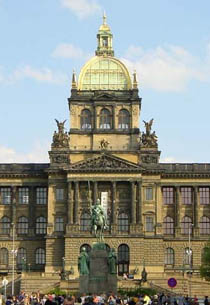
The National Museum will undergo reconstruction after 120 long years
 |
The time for builders comes now; on Thursday, July 7, people will be able to walk through the halls of the National Museum for the last time in a long while. The result of the renovations, which are expected to cost 4.5 billion crowns, will be not only the doubling of exhibition space but also a direct connection to the building of the former federal parliament via an underground tunnel or a lookout in the previously unused dome. If everything goes according to plan, the renovated museum will welcome visitors in its new form in four years, in June 2015.
The representative seat of the then Museum of the Kingdom of Bohemia, with its gilded dome, is unmistakable, especially when viewed from Letná, and was built not far from the demolished New Horse Gate in the location where the New Town walls stood until 1875. Today, viewing the museum's location between two directions of a busy thoroughfare, it is hard to imagine that the building originally stood in the middle of a tranquil park that seamlessly connected to the former Horse Market. Part of the museum ramp was to include a planned monument to Prince Václav.
This was opposed by the sculptor, Josef Václav Myslbek, who was supported by patron Josef Hlávka, and architect Schulz ultimately lost his battle; the equestrian statue stands a few meters lower in the square. Schulz’s creation, which was inspired by the building of the New Hermitage in St. Petersburg according to recent research, is nevertheless rich in artistic decoration. It involved prominent artists including Myslbek and his colleagues Jan Štursa and Ladislav Šaloun, as well as painters Václav Brožík, Vojtěch Hynais, and Julius Mařák.
However, neither the magnificent decoration of the exterior nor the interior—especially impressive is the Pantheon with sculptures and paintings reminiscent of Czech history, which was Schulz’s trump card in the architectural competition—motivated the public to immediately embrace the building. The museum staff themselves had reservations about it, for whom the building was created. The project hardly counted on deposits; besides exhibition spaces and offices, it only provided a storehouse for 300,000 volumes and a rather small storage area for collections of minerals and fossils.
The mentioned shortcomings became apparent during urgent operations; after all, in size, it was not even sufficient for the most famous exhibit, the skeleton of a sperm whale. The whale, which was presented to the public in 1893, was too long and had to be shortened by several tail vertebrae before it could be displayed. Additionally, the appearance of the new museum palace was harmed by the omnipresent smoke from chimneys and factories at that time. "If it goes on like this, in five years it will look like inside a chimney and the collections in it like pigs in rural filth," lamented Jan Neruda.
Although the writer's prediction did not come true—despite the façade of the National Museum still suffering from exhaust—management of the institution soon began to contemplate expansion ideas. Shortly before World War I, plans were unveiled for an extension that was to rise on the site of Čelakovského Sady. However, the project was never realized, just like several others. The museum had to wait until 2006 for additional space in the immediate vicinity, when it acquired the building of the former Federal Assembly.
The English translation is powered by AI tool. Switch to Czech to view the original text source.
0 comments
add comment
Related articles
0
24.10.2018 | The National Museum celebrates its 150th anniversary with the reconstruction of the main building
0
14.09.2018 | In front of the National Museum will be the once-planned Palach Monument
0
05.06.2018 | Prague will contribute 52 million CZK for adjustments around the National Museum
0
18.05.2018 | People will see the work of restorers and new spaces in the renovated museum
0
16.05.2018 | National Museum is 80 percent complete, people will see it on Saturday
0
02.12.2017 | Prague is preparing adjustments to the surrounding area of the National Museum
0
11.11.2017 | <Národní muzeum už připravuje expozice o přírodě>National Museum is already preparing exhibitions about nature</Národní muzeum už připravuje expozice o přírodě>
0
12.10.2017 | The renovation of the National Museum is going according to plan, it will open next year
0
11.06.2017 | The new National Museum will be seen by people in the summer, exhibitions will start in a year
0
24.01.2017 | The entire National Museum will be accessible after restoration by mid-2020
0
17.05.2016 | 125 years ago, the building of the National Museum in Prague was opened.
0
12.02.2016 | The National Museum burned at night; the damage should not be extensive
0
22.07.2015 | The National Museum announced an architectural competition for its exhibitions
1
20.04.2015 | The architectural competition for the exhibitions of the National Museum is being prepared
0
15.04.2015 | National Museum signed a contract with the winner of the tender for reconstruction
0
08.04.2015 | The billion-dollar reconstruction of the National Museum has the green light from the Office for the Protection of Competition
0
29.01.2015 | The reconstruction of the National Museum building could begin as early as spring
0
15.01.2015 | The reconstruction of the National Museum is delayed
0
31.01.2014 | Herman should complete the reconstruction of the National Museum according to Sobotka
0
07.01.2014 | The National Museum cannot yet sign a contract for the reconstruction
0
18.11.2013 | Seven applicants want to reconstruct the historical museum building
0
13.05.2013 | The National Museum announced a tender for the reconstruction of the main building
0
28.12.2011 | The National Museum is preparing tenders for the reconstruction of the building
2
22.07.2011 | Architects recommend a competition for the exhibitions of the National Museum in Prague
0
21.04.2011 | <Národní muzeum> will start counting down 77 days until the five-year closure











